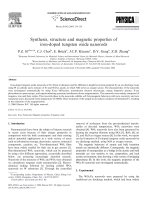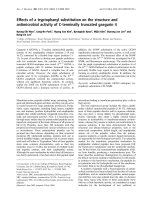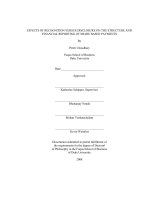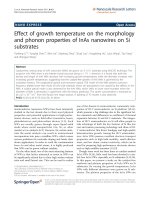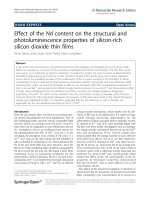Investigation on the structure and magnetic properties of co2mnsi heusler alloy for spintronic application
Bạn đang xem bản rút gọn của tài liệu. Xem và tải ngay bản đầy đủ của tài liệu tại đây (2.7 MB, 100 trang )
Acknowledgements
This author would like to express her heartfelt gratitude to her supervisors,
Dr. Chen Jingsheng and Dr. Han Guchang for their guidance, advice, concern and
encouragement throughout the course of the project.
The author would like to thank Dr Qiu Jinjun for the introduction and
maintenance of ULVAC sputter system, and Miss Luo Ping for the help in XPS
analysis.
In addition, the author is grateful for the friendship and support of Huang
Lisen, Yang Yang, Ho Pin, Xu Dongbin, Si Huayan, Chen Chin, Li Huihui, Ko
Viloane, Lim Boon Chow, and other research staff and students in the Department
of Materials Science and Engineering and Data Storage Institute.
Last but not least, the author would like to thank her family for their love,
support and understanding during the period of research project.
i
Table of Contents
Acknowledgements
i
Table of Contents
ii
Summary
v
List of Figures
vii
List of Symbols
xi
Chapter 1:Introduction
1
1.1 Gaint magnetoresistance (GMR) read head technology .................................... 3
1.1.1 Physics of GMR effect .............................................................................. 3
1.1.2 Current-in-plane (CIP) spin valve............................................................. 6
1.1.3 Current-perpendicular-to-plane (CPP) spin valve ................................... 8
1.2 Tunnel magnetoresistance (TMR) read head technology ................................ 10
1.3 Challenges for next generation read head over 1 Tbits/in 2 .............................. 11
1.4 Literature review of Co2MnSi half-metallic Heusler alloys ............................ 12
1.4.1 Basic properties of Heusler alloys .......................................................... 13
1.4.1.1 Origin of the bandgap.................................................................. 14
1.4.1.2 Slater-Pauling behavior ............................................................... 15
1.4.2 Parameters affecting MR ratio of CPP-GMR head using Co2 MnSi
Heusler alloy ...................................................................................................... 17
1.4.2.1 Effect of lattice parameter........................................................... 17
1.4.2.2 Spin-orbit coupling ...................................................................... 19
1.4.2.3 Effect of temperature on spin polarization ................................ 19
1.4.2.4 Effect of disorder, defects, and doping ...................................... 20
1.4.2.5 Other factors from device perspective ....................................... 21
1.5 Objective of thesis .............................................................................................. 22
1.6 Outline of thesis.................................................................................................. 24
ii
Chapter 2: Experimental methodologies
25
2.1 Sample fabrication by magnetron sputtering .................................................... 25
2.2 Alternating gradient force magnetometer ......................................................... 26
2.3 X-ray diffraction ................................................................................................. 27
2.3.1 θ - 2θ x-ray scans ..................................................................................... 29
2.3.2 Rocking curve .......................................................................................... 29
2.3.3 Phi-scans ................................................................................................... 30
2.4 Transmission electron microscopy .................................................................... 31
2.5 X-ray photoelectron spectroscopy..................................................................... 32
2.6 Atomic force microscopy .................................................................................. 33
Chapter 3: MgO buffer layer effect on the structure and magnetic properties
of Co2MnSi (CMS) films on MgO substrates
34
3.1 Study of CMS thin films on MgO substrates (no buffer layer) ....................... 34
3.1.1 Experimental methods ............................................................................. 35
3.1.2 Results and discussion ............................................................................. 36
3.1.2.1 Structure properties ..................................................................... 36
3.1.2.2 Magnetic properties ..................................................................... 39
3.2 Study of CMS thin film on MgO-buffered MgO substrates ............................ 44
3.2.1 Experimental details ................................................................................ 44
3.2.2 Results and discussion ............................................................................. 45
3.2.2.1 Crystallographic structure ........................................................... 45
3.2.2.2 In-plane epitaxial growth relationship ....................................... 46
3.2.2.3 Heusler L21 texture...................................................................... 48
3.2.2.4 Microstructure ............................................................................. 49
3.2.2.5 Magnetic properties ..................................................................... 50
3.3 Summary ............................................................................................................. 54
iii
Chapter 4: Cr buffer layer effect on the texture and magnetic properties of
Co2MnSi (CMS) films
56
4.1 Experimental methods
56
4.2 Results and discussion ....................................................................................... 58
4.2.1 Effect of CMS in-situ annealing temperature ........................................ 58
4.2.1.1 Crystallographic structure ........................................................... 58
4.2.1.2 Cr/CMS interface and multi-layer roughness ............................ 63
4.2.1.3 Magnetic properties ..................................................................... 64
4.2.1.4 Microstructure ............................................................................. 68
4.2.2 Effects of Cr in-situ annealing temperature ........................................... 69
4.3 Summary ............................................................................................................. 72
Chapter 5: Conclusions and future work
74
5.1 Conclusions ........................................................................................................ 74
5.2 Future work......................................................................................................... 75
Publication
76
References
76
iv
Summary
The effects of MgO and Cr buffer layers on the structures and magnetic
properties of Co2 MnSi (CMS) thin films have been studied. The CMS thin films
were deposited on MgO (001) single crystal substrates with and without MgO or Cr
buffer layer at room temperature by magnetron sputtering deposition and annealed
at various temperatures. From 2-theta and Phi-XRD analysis, it was found that both
MgO and Cr buffer layers could help induce the (001) epitaxial growth of the CMS
thin films with B2 or L21 structure, while A2 structure was formed in the films
without buffer layer. A four-fold 45ºshift between MgO (022) peaks and Cr (022)
or CMS (022) peaks was obtained in the Phi-scan analysis of the post-annealed
MgO- and Cr-buffered CMS thin films, which confirmed the epitaxial relationship
of CMS [110](001) || MgO [100](001) and CMS [110](001) || Cr [110](001) || MgO
[100](001). A smoother MgO buffer layer surface was obtained in an Ar+O2
atmosphere compared to that obtained in Ar atmosphere, which resulted in a
stronger CMS (001) texture. Moreover, it was found that the in-situ annealing of
the Cr buffer layer at 500°C destroyed the homogenous surface, while the RTdeposited Cr layer showed a very smooth surface and subsequently gave a better
CMS crystallinity. The saturated magnetization of the CMS thin films increased
v
with annealing temperature below 600ºC and then decreased when annealed further
at 600ºC. A chemical analysis of inter-diffusion was examined and the results
indicated significant diffusion of Pt and Co in the MgO-buffered CMS thin films
annealed at 600°C for 1h and Cr in the Cr-buffered CMS thin films annealed at
600°C for 15min. Large initial susceptibilities were found in the Cr buffered CMS
thin films. For the MgO/CMS/Pt samples post-annealed at 600ºC, three-stage initial
curves were obtained, suggesting a pinning behavior in the magnetic reversal
mechanism.
vi
List of Figures
Figure 1.1: Data storage roadmap of HDDs. Adapted from [1].
1
Figure 1.2: Magnetoresistance magnitude of GMR versus TMR. Adapted from [5].
3
Figure 1.3: Normalized resistance versus applied magnetic field at 4.2K with CIP
current. Adapted from [19].
4
Figure 1.4: Two current model of GMR effect with F/C multi-layers.
5
Figure 1.5: Schematic representation of an exchange biased spin valve structure, in
which the magnetization of one ferromagnetic layer is fixed by
exchange
coupling to an antiferromagnetic layer. The
other
ferromagnetic layer has it magnetization direction changed by external
magnetic field.
6
Figure 1.6: Different spin valve structures: (a) bottom type; (b) top type; (c) dual
type, Cap: capping layer; FL: free layer; NM: non-magnetic layer; RL:
reference layer; PL: pinned layer, AFM: anti-ferromagnetic layer; SL:
the seedlayer.
7
Figure 1.7: The (a) CIP and (b) CPP GMR read head geometry. Adapted from [11].
8
Figure 1.8: Schematic density of states for both magnetic electrodes with the
parallel
and
anti-paralle
arrangement
of
magnetizations.
The
conductivity of each spin channel is proportional to the spin DOS in the
emitter and collector electrode. Adapted from [19].
10
Figure 1.9: Schematic representation of the DOS for a half-metal with respect to
normal metals and semiconductors [33].
13
Figure 1.10: Structure of (a) C1 b half-Heusler alloys; (b) L21 full-Heusler alloys; (c)
B2 full-Heusler alloy; (d) A2 full-Heusler alloy. Adapted from [32].
13
Figure 1.11: Major combination of Heusler alloy formation. Adapted from [32].
14
Figure 1.12: Origin of the minority band gap in (a) NiMnZ and (b) Co 2MnZ.
Adapted from [32].
15
vii
Figure 1.13: Calculated total spin moments, in which dashed line represents the
Slater-Pauling behavior. Adapted from [40].
16
Figure 1.14: DOS for NiMnSb and CoMnSb . Adapted from [40].
18
Figure 2.1: M-H loop of ferromagnetic materials. Adapted from [69].
27
Figure 2.2: Illustration of x-ray diffraction. Adapted from [74].
28
Figure 2.3: X-ray powder scans geometry. Adapted from [75].
29
Figure 2.4: Phi-scan X-ray diffraction geometry.
31
Figure 3.1: (a) L21 structure of CMS; (b) top view of MgO/Co2MnSi crystal
structure.
34
Figure 3.2: Schematic diagram of MgO(sub)/CMS/Pt layered structure.
36
Figure 3.3: AFM image of MgO substrate surface topography.
36
Figure 3.4: 2-theta XRD spectra of CMS films deposited at RT and post annealed at
400°C and 600°C. All peaks labeled in * are from MgO substrate.
37
Figure 3.5: In-plane hysteresis loops of CMS films: (a) deposited at room
temperature; (b) post-annealed at 400°C; (c) post-annealed at 600°C; (d)
extracted Ms and Hc curves as a function of temperature.
40
Figure 3.6: Line-scan EDX spectra of CMS thin films deposited on MgO substrates
at room temperature and annealed at (a) 400°C and (b) 600°C.
41
Figure 3.7: The initial curves of both as-deposited CMS films and CMS films postannealed at 400°C and 600°C. (1), (2), (3) represents for initial stage,
second stage, and third step, respectively.
42
Figure 3.8: Schematic of MgO(sub)/MgO/CMS/Pt multi-layer structure.
44
Figure 3.9: The 2-theta XRD spectra of CMS deposited at RT and post-annealed at
various temperatures with 7nm MgO buffer layer deposited in (a)
Ar+O2 and (b) Ar atmosphere.
45
viii
Figure 3.10: The three dimension model of crystal structure of epitaxial grown
MgO/CMS layers.
46
Figure 3.11: Phi-scan images of CMS {022} and MgO {022} planes in MgObuffered CMS thin films annealed at (a) 400°C and (b) 600°C.
47
Figure 3.12: Phi-scan spectra for CMS (111) peaks of MgO-buffered CMS thin
films annealed at 400°C and 600°C.
48
Figure 3.13: Cross-sectional TEM images and IFFT image of the atomic lattice of
MgO-buffered CMS with MgO deposited in (a) Ar; (b) Ar+O 2 gas
atmosphere.
50
Figure 3.14: M-H loops of MgO-buffered CMS with MgO deposited in (a) Ar+O 2;
(b) Ar gas atmosphere; extracted (c) Ms and (d) Hc curves as a function
of temperature.
52
Figure 3.15: The XPS depth profile of MgO(7nm)-buffered CMS films: (a)
deposited at room temperature; (b) annealed at 400°C; (c) annealed at
600°C; (d) initial magnetization curves.
53
Figure 4.1: (a) L21 structure of CMS; (b) Top view of MgO/Cr/CMS crystal
structure.
56
Figure 4.2: Schematic of MgO(sub)/Cr/CMS/Pt layer structure.
57
Figure 4.3: The spectra of 2-theta XRD of Cr/CMS/Pt multi-layers.
58
Figure 4.4: (a) CMS (002) and (004) Peak-integration and (b) Rocking curve of
CMS (002) peak as a function of temperature.
59
Figure 4.5: The 3-D crystal structure model of epitaxial grown MgO(sub)/Cr/CMS
layers.
60
Figure 4.6: Phi-scans of MgO, Cr and CMS {022} planes of Cr-buffered CMS thin
films annealed at (a) 300°C; (b) 400°C; (c) 500°C; (d) 600°C.
62
Figure 4.7: Phi-scan of CMS (111) peaks of Cr-buffered CMS films annealed at
600°C.
62
ix
Figure 4.8: AFM images of as-deposited Cr buffer layer.
63
Figure 4.9: AFM images of Cr/CMS/Pt multi-layers: (a) deposited at room
temperature; (b) annealed at 300°C; (c) annealed at 400°C; (d) annealed
at 500°C; (e) annealed at 600°C.
64
Figure 4.10: (a) In-plane hysteresis loop of Cr-buffered CMS films deposited at
room temperature and post-annealed at various temperatures; (b)
extracted Ms and Hc curves as a function of temperature.
65
Figure 4.11: The initial curve of Cr-buffered CMS films.
66
Figure 4.12: XPS depth profile of Cr/CMS/Pt multi-layers in which CMS thin films
were: (a) deposited at room temperature; (b) annealed at 300°C; (c)
annealed at 500°C; (d) annealed at 600°C.
67
Figure 4.13: Cross-sectional TEM images of Cr/CMS/Pt layers in which CMS films
were annealed at (a) 300ºC; (b) 400ºC; (c) 500ºC, (d) high resolution
TEM image of Cr/CMS/Pt multi-layers in which CMS films were
annealed at 500ºC.
69
Figure 4.14: 2-theta spectra of Cr/CMS/Pt multi-layers with various Cr in-situ
annealing temperatures.
70
Figure 4.15: AFM images of Cr(10nm)-buffered MgO substrates with Cr in-situ
annealing for 30min at (a) 300°C; (b) 400°C; (c) 500°C; (d) 600°C.
71
x
List of Symbols
Wavelength
Θ
Angle theta
ω
Angle omega
ψ
Angle Phi
Φ
Angle Psi
AC
Alternating current
AD
Areal density
AFM
Atomic force microscopy
AMR
Anisotropic magnetoresistance
AGFM
Alternating gradient force magnetometry
B
Bit length
BE
Binding energy
BF
Bright-field
CIP
Current in plane
CPP
Current-perpendicular-to-plane
d
Spacing between pole tip of head and magnetic layer
xi
dhkl
Interplanar spacing
DF
Dark-field
DC
Direct current
DSI
Data Storage Institute
DOS
Density of States
EDX
Energy-dispersive X-ray spectroscopy
EF
Fermi Energy
FL
Free layer
fcc
Face-centered cubic
FM
Ferromagnetic
FWHM
Full width at half maximum
GMR
Giant magnetoresistance
Hc
Coercivity
HDD
Hard disk drive
HR
High-resolution
Hin
Interlayer coupling
IFFT
Inverse Fast Fourier Transform
xii
KE
Kinetic Energy
MTJ
Magnetic tunnel junction
Mr
Remanent magnetization
Ms
Saturation magnetization
Mt
Total moments per formula unit
N
Number of points
NM
Nonmagnetic
PVD
Physical Vapor Deposition
PL
Pinned layer
△ RA
Resistance Change per Unit Area
RAMAC
Random Access Method of Accounting and Control
RF
Radio frequency
Ra
Surface roughness average
Rrms
Mathematical Root Mean Square Roughness
SV
Spin valve
SOC
Spin-orbit coupling
TMR
Tunneling Magnetoresistance
xiii
T
Temperature
Tc
Curie temperature
TEM
Transmission electron microscopy
XRD
X-ray diffraction
XPS
X-ray photoelectron spectroscopy
Zt
Total valence electrons number
Zavg
Average value of valence electrons number
Zi
Current value of valence electrons number
xiv
Chapter 1: Introduction
Hard disk drives (HDD) have a leading position in the digitalized information storage
area, accompanied by a dramatic increase in storage density at a rate larger than 40% per year.
Fig. 1.1 shows the evolution and roadmap of HDD data storage [1]. The first magnetic HDD
called the Random Access Method of Accounting and Control was introduced by IBM with an
areal density (AD) of 2000 bits/in2 . To date, HDDs with AD of around 500 Gbits/in2 are widely
used. Recently, HDD with AD of around 803 Gbits/in2 has been demonstrated in the lab [2].
Figure 1.1: Data storage roadmap of HDDs. Adapted from [1].
1
The fast developing speed in HDD industry is closely related to the development in the
field of spintronics in read head technology. The first breakthrough came in 1991 when the
inductive read head was replaced by the anisotropic magnetoresistive (AMR) read head.
Magnetoresistance (MR) refers to the resistance variation, between maximum and minimum
resistances, normalized against the minimum resistance value when the magnetic field changed.
The readout signal is proportional to the MR ratio. Although the MR ratio of AMR head was
only 1%, it was more than double the value demonstrated by inductive read head.
The second major development of the read head technology came with the discovery of
the giant magnetoresistance (GMR) effect by Fert’s group [3] in France as well as Grunberg’s
group [4] in Germany in 1988. In 1997, the first GMR read head was introduced in commercial
HDDs with AD of around 2 Gbits/in2. However, this GMR read head with current-in-plane (CIP)
geometry possessed some key limitations. As such, both current-perpendicular-to-plane (CPP)GMR and tunneling magnetoresistance (TMR) read heads were investigated as promising
candidates to replace this CIP-GMR read head. Fig. 1.2 shows the magnetoresistance of GMR
versus TMR [5]. The output signal of MgO and Al2O3 based TMRs indicated a larger
magnetoresistance than the CPP-GMR read head. In 2005, Seagate introduced the first TMR
read head with both MgO and Al2O3 insulators.
2
Figure 1.2: Magnetoresistance magnitude of GMR versus TMR. Adapted from [5].
1.1 Gaint magnetoresistance (GMR) read head technology
1.1.1 Physics of GMR effect
The giant magnetoresistance (GMR) effect was discovered in iron (magnetic) and
chromium (non-magnetic) alternating layers. In these structures, when the magnetization
directions in neighbouring iron layers changed from antiparallel to parallel, a significant change
in resistance was observed. This phenomenon was known as GMR. For samples with 9 Å Cr
layers, the MR (MR = [ρAP –ρP]/ ρP) ratio increased four-fold from 20% at room temperature to
80% at 4.2 K, as shown in Fig. 1.3.
3
Figure 1.3: Normalized resistance versus applied magnetic field at 4.2K with CIP current. Adapted
from [19].
In these multilayer structure, the anti-parallel arrangement of magnetization between
adjacent ferromagnetic (FM) layers resulted in high resistivity while a parallel arrangement of
the magnetization led to an obvious reduction of resistivity magnitude. However, the saturation
field Hs required to overcome the antiferromagnetic interlayer coupling effect and align the
magnetization of consecutive layers was too large for GMR to be applicable in real devices. On
the other hand, further investigation revealed that the anti-ferromagnetic coupling arrangement
was not a prerequisite for the GMR effect [6].
The physical origin of GMR effect can be explained by the effect of the electron spin on
the electronic transport in ferromagnetic conductors, i.e. spin-dependent scattering. A qualitative
understanding of GMR effect was given by Mott’s two-current model [7], as shown in Fig. 1.4.
4
The key point of this model is that two independent conduction carriers – spin up and spin down
electrons existed in FM conductors.
Figure 1.4: Two current model of GMR effect with F/C multi-layers.
As the resistance of the multi-layer structure arose from the scattering processes of spin
electrons, strong scattering led to short mean free path, while weak scattering led to long mean
free path. When the magnetization directions of two ferromagnetic layers were parallel, the spinup electrons, assumed to be parallel to magnetization, passed through the multi-layers with
almost zero scattering. On the other hand, the spin-down electrons were scattered strongly as
their spin aligned anti-parallel to the magnetization direction. Thus, parallel configuration
resulted in low resistivity. If the magnetizations in the two ferromagnetic layers were anti-
5
parallel, high resistivity would be induced as both spin-down and spin-up electrons would be
scattered strongly.
1.1.2 Current-in-plane (CIP) spin valve
Figure 1.5: Schematic representation of an exchange biased spin valve structure, in which the
magnetization of one ferromagnetic layer is fixed by exchange coupling to an antiferromagnetic
layer. The other ferromagnetic layer has it magnetization direction changed by external magnetic
field.
With the discovery of the GMR effect in the CIP case, S.S. Parkin’s group proposed a
CIP spin valve (SV) structure, as shown in Fig. 1.5. This SV structure, composed of four layers,
had a much smaller switching magnetic field (Hs) which make the GMR effect practical for
spintronic devices [8]. The magnetization of the pinned layer (PL) would be pinned along the
anti-ferromagnetic (AFM) layer field cooling direction, while the magnetization of the free layer
(FL) would change with the external field. The pinning effect was not only the result of
unidirectional anisotropy generated by domains but also that of interface exchange coupling.
6
Figure 1.6: Different spin valve structures: (a) bottom type; (b) top type; (c) dual type, Cap:
capping layer; FL: free layer; NM: non-magnetic layer; RL: reference layer; PL: pinned layer,
AFM: anti-ferromagnetic layer; SL: the seedlayer.
In a read head sensor, it would be crucial to reduce the interaction influence of the pinned
layer on the free layer, due to interlayer and magnetostatic coupling H in. On one hand, Hin can be
reduced by increasing the NM layer thickness. However, this would reduce the MR signal
through scatterings which decreased the flow of polarized conduction electrons [9]. On the other
hand, a synthetic anti-ferromagnetically coupled pinned layer [10] can be used, as shown above
in Fig. 1.6 (a). This spin valve structure with pinned layer deposited first (bottom type) would
reduce or even cancel off the stray field generated from the pinned layer. Fig. 1.6 (b) gives a
reversed strucuture (top type) where the free layer was deposited first. The dual spin valve in Fig.
1.6 (c) shows a combination of both top and bottom types. Although this structure gave higher
7
MR ratio, it required more spacing between shields in devices. Therefore, this dual spin valve
was limited for ultrahigh density recording.
1.1.3 Current-perpendicular-to-plane (CPP) spin valve
Since the discovery of the GMR effect, much works had been done with the CIP spin valve
structure. It was relatively easy to measure the resistance of thin films with CIP geometry, while
the resistance measurement of CPP spin valves required complicated nano-scale device
fabrication process as the sensor length was quite small. However, CIP-GMR had two main
limitations, as shown in Fig. 1.7 (a).
(a) CIP
(b) CPP
Figure 1.7: The (a) CIP and (b) CPP GMR read head geometry. Adapted from [11].
8
(1) Two insulator gaps existed between the sensor and the two shields. A smaller gap would
promote higher linear density. As such, the ideal condition was to eliminate the gap.
However, this would result in a short circuit between the shield and sensor.
(2) The reduction of track width could result in a conflict between higher track density and
linearly decreased output signal.
Unlike the CIP geometry, the two gaps were not necessary in a CPP spin valve head as
the current flowed from the top shield to the bottom shield through sensor stack. In addition, both
theoretical [12] and experimental results [13] revealed that the CPP-GMR showed higher
intrinsic MR ratio compared to CIP-GMR. The physics involved in the MR measurement of CIP
and CPP geometry was significantly different. In a theoretical paper by T. Valet and A. Fert in
1993 [14], they showed that the most important difference between the CPP and CIP was
induced by the spin transport process. For CPP, the spin transportation was perpendicular to film
interface, which included a spin accumulation effect. This effect allowed the spin transportation
in CPP-GMR to be dependent on the long spin diffusion length rather than the short mean free
path in CIP geometry. Moreover, a spin dependent interface resistance introduced by specular
reflection can also be found in CPP spin valve. The famous Fert-Valet model, which mainly
focused on the effect of bulk and interface spin-asymmetry coefficients, was then widely used in
the investigation of CPP-GMR devices.
9
Unfortunately, the MR ratio of CPP-GMR still fell below the value required to achieve
sufficient bit error rate for areal density exceeding 300 Gbits/in2 [15-18] after several years of
investigation. The current used read head is based on CPP-TMR.
1.2 Tunnel magnetoresistance (TMR) read head technology
When the metallic NM layer in a tri-layer GMR spin valve is replaced by a thin insulator,
the mechanism for MR becomes spin dependent tunneling. This phenomenon is called tunneling
magneto-resistance (TMR) and the junction is called magnetic tunnel junction (MTJ).
Figure 1.8: Schematic density of states for both magnetic electrodes with the parallel and antiparalle arrangement of magnetizations. The conductivity of each spin channel is proportional to the
spin DOS in the emitter and collector electrode. Adapted from [19].
The tunneling process was not only dependent on the available electronic channels in FM
electrodes like in GMR, but also dependent on thickness and height of barrier. Julliere reported
the first work of TMR measurement in a Co/Oxided-Ge/Fe MTJ in 1975 [20]. In his article,
10
Julliere proposed an explanation of spin polarized tunneling effect. Assuming spin conservation
in the tunneling process, the conductance can be understood by the sum of two independent
channels, as shown in Fig. 1.8 [19]. The famous Julliere formula relates the relative change of
conductance with the density of states of each spin channel:
TMR=
Di Di
2 P1 P2
, where Pi =
Di Di
1 P1 P2
D is the DOS of the FM electrodes for spin-up and spin-down direction at Fermi level.
Researches on TMR have been very active since 1995 and major breakthroughs were
made in 2004 at both Tsukuba (Yuasa et al) and IBM (Parkin et al). It was found that very large
TMR ratio (200% at room temperature) could be obtained from MTJ with high quality MgO
barrier. TMR ratio of about 600% was reported later [21]. However, the major challenge of TMR
head was its high resistance, which limited the working frequency and thus reading speed.
Reducing the insulating layer thickness also introduced pin-holes into the structure and
deteriorated its performance.
1.3 Challenges for next generation read head over 1 Tbits/in2
As discussed above, TMR-based sensors with higher output signal have replaced CIPGMR sensors in HDD read heads. However, there is increasing interest to replace TMR-heads
11



